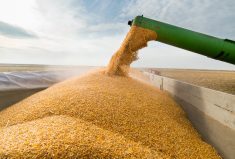As the late Yogi Berra once said, it’s “déjà vu all over again” as Canadian livestock producers nervously monitor new developments south of the border that threaten to unravel the tightly knit North American meat trade.
The USDA Food Safety and Inspection Service is seeking comment until May 12 on a plan to tighten its meat labelling rules to require products labelled as “product of the USA” to consist only of meat from animals born, raised, slaughtered and processed in the U.S.
As it now exists, marketers can use the so-called PUSA label on meat or poultry products made from imported animals, mainly from Canada or Mexico, and then fed and slaughtered domestically. They can also use it on meat products imported, repackaged or further processed in the U.S.
Read Also

The new spin on farm legacy
Farmers are starting to think differently about the future of their farms in Western Canada. What does this mean for the next generation and farm succession planing?
The implications of the change could be profound for Canadian producers who annually ship about 4.8 million feeder pigs, 840,000 slaughter hogs and 600,000 to 700,000 head of cattle to U.S. buyers.
With North American cattle herds dipping to 60-year lows, the free flow of trade between the two countries is more important than ever to keep meat on consumers’ tables.
Use of the proposed label is voluntary, which is significantly different from the mandatory country-of- origin labelling law that plagued the Canadian industry between 2008 and 2014.
The mCOOL required all meat sold in the U.S. to carry a label declaring where it originated. In practical terms, it meant that U.S. processors had to segregate Canadian and U.S. animals before processing them, which caused them to either shy away from buying Canadian-born animals or pay a lot less.
That regulation was eventually shot down by the World Trade Organization in 2012, but not before it cost the Canadian industry billions in lost sales and more than $4 million in legal fees as lawyers ushered the grievance through diplomatic channels and, ultimately world trade courts.
So meat marketers don’t have to use the PUSA label, but if they do, they would have to comply with it provisions.
As with most trade hiccups, this one is politically motivated. Industry organizations who feel imported livestock undermines American producers have petitioned the federal regulator three times since 2018. Legislation calling for the change was introduced to the House of Representatives and the Senate in 2021.
The Canadian government says it is monitoring the situation with concern, as are organizations representing Canadian cattle and hog producers.
Do consumers really care?
The USDA commissioned research firm RTI International to survey consumers on three questions: Do consumers notice the “Product of USA” labels? Second, do they understand the meaning of that label and other USDA labelling related to quality? Thirdly, how much more are they willing to pay?
When consumers viewed a mock meat product and were then asked to recall what they saw, only one in 10 remembered seeing the label. If it also carried an icon of the American flag, their recall rose to one in three.
Nearly 80 per cent remembered seeing the label if they were explicitly asked whether they saw it. However, 15 per cent of respondents reported seeing the label even when it wasn’t on the package, a testament to how much noise there is around product labelling.
Only 16 per cent of consumers knew the current label applies to products processed in the U.S. but not necessarily from animals born there. Nearly two- thirds believed all production steps took place in the U.S.
Consumers said they were willing to pay 24 to 43 per cent more for meat products sold under the label by either definition. However, a second cost-benefit analysis found the price premiums for U.S.-origin claims to be small relative to other marketing claims such as organic, grass-fed, no antibiotic or hormones, or natural — some of which have no regulated definition.
So, this change might make a few politicians feel good, but it won’t put many more dollars into American farmers’ pockets.
As for the Canadians, no one knows whether this proposed change will be a wrinkle or a rift in the live animal trade between the two countries. It’s a safe bet that it won’t help.
















